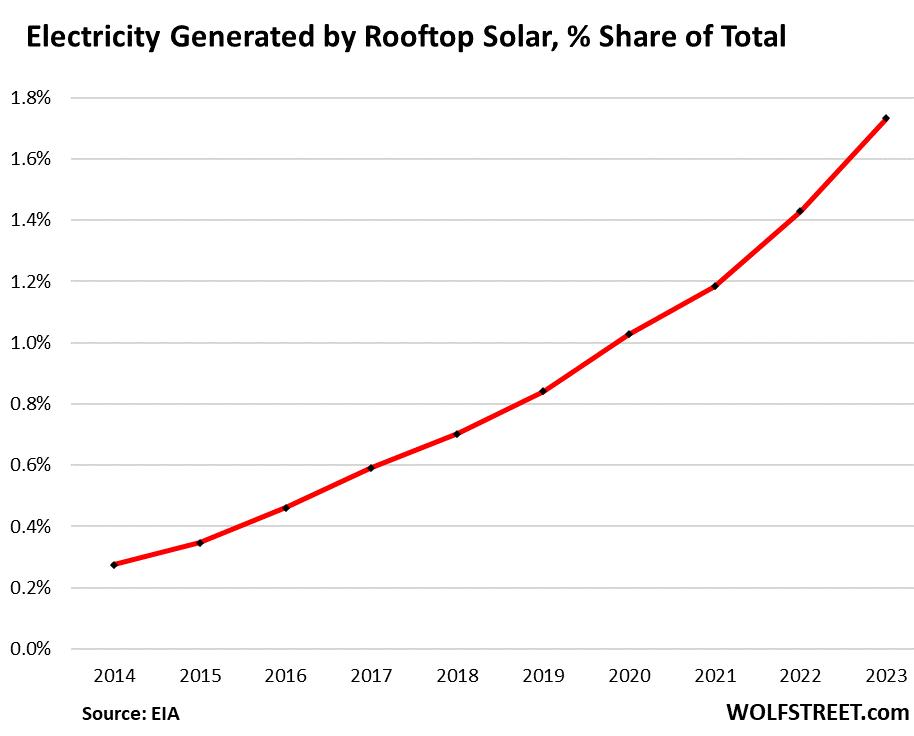Link: https://wolfstreet.com/2024/02/27/u-s-electricity-generation-bysource-in-2023-natural-gas-coal-nuclear-wind-hydro-solar-geothermalbiomass-petroleum/
Please see link above for source text.

Link: https://wolfstreet.com/2024/02/27/u-s-electricity-generation-bysource-in-2023-natural-gas-coal-nuclear-wind-hydro-solar-geothermalbiomass-petroleum/
Please see link above for source text.
The quantity of electricity generated in the US declined by 0.9% in 2023 from the record in the prior year, to 4,247,732 gigawatt-hours, according to data from the EIA today.
But compared to 2007, over those 16 years, electricity generation was up only 2.3%. Power generators in aggregate had gotten mired in stagnating demand, despite the growing economy and population. A big factor was that electricity users, to reduce their costs, invested in more efficient equipment – lights, appliances, electronic equipment, industrial equipment, heating and air-conditioning, etc. – and in better building insulation, shading, etc., to reduce their costs. But in 2022, demand jumped to a record amid a big heat wave in a big part of the US, EV charging, crypto mining, etc.
The chart shows the total amount of electricity generated each year by all sources, from natural gas to roof-top solar. The blue line connects 2021 and 2007: 1

The share of total electricity generated by source:
Natural gas has been hard to beat in the US, in terms of costs and flexibility for power generation. Fracking has turned the US into the biggest natural gas producer in the world, with surging exports. Production has oversupplied the US market and has caused the price of natural gas to collapse since 2009.
In addition, the modern combined-cycle natural gas powerplants have a thermal efficiency of around 65%, nearly double that of older coal powerplants.
The low price of natural gas and the high efficiency of the modern powerplants has caused the share of natural gas as source for power generation to increase from record to record, surpassing nuclear in 2006 and coal in 2016. In 2023, the share of electricity generated by natural gas powerplants surged to another record: 42.7% of total power generated (blue in the chart below).
Coal dropped to another record low of 15.9%, in terms of its share of total power production, down from 51% in 2001 (black in the chart below).
Fracking (causing the price of natural gas to collapse since 2009), the combined-cycle gas turbine (a technical innovation from the 1990s that vastly increased the efficiency of natural gas plants), and later wind, and more recently solar knocked King Coal of its perch over the past two decades.
It all boils down to costs. Gas is cheap. With renewables, the “fuel” is free; and all methods of power generation require costly plants and equipment.
Coal power plants cannot compete with a combined-cycle natural gas plant and can no longer even compete with wind and solar. Power generators have not built any new coal-fired power plants over the past decade. They’re just too inefficient and expensive to operate.
All renewables combined – in that order: wind, hydro, solar, geothermal, and biomass – increased their share of total power production by a hair to 22.8% (red).
Nuclear power’s share of total generation inched up to 18.3% (green).
Petroleum liquids and petroleum coke have nearly vanished as source of power generation, down to 0.4% (purple).
The chart below shows the quantity of electricity generated by source since 2001. “Renewables” include wind, hydro, solar including rooftop, geothermal, and biomass. More on them separately in a moment.

Wind power generation dipped in 2023 from the huge record in 2022 to 425,235 gigawatt-hours, and its share of total power generated dipped to 10.0%. Wind-power generation by state:
1. Texas
2. Iowa
3. Oklahoma
4. Kansas
5. Illinois
6. California
Hydropower dipped to 5.6% of total power generation.
Solar – including rooftop solar – surged to a new record share of 5.6% of the total power generated (up from 4.8% in the prior year), essentially matching hydropower. Solar was the only source that gained share. Solarpower generation by state:
1. California
2. Texas
3. Florida
4. Arizona
5. North Carolina
6. Nevada
Biomass & geothermal combined has a share of 1.5% of total power generated. Biomass includes several small categories such as wood and wood-derived fuels, landfill gas, and other waste biomass. Most geothermal plants are in California, built in the 1970s.

Small-scale solar, such as rooftop systems, jumped to 73,619 gigawatthours, for a share of 1.7% of total power generated in 2023. Generation has multiplied by over 6 times since 2014 (the first year the EIA started tracking it).

Battery storage: booming price arbitrage.
Battery storage isn’t a power generator. But it makes an arbitrage possible: Buying electricity during periods of the day when demand and wholesale prices are low, and selling electricity during the time of the day when demand peaks and prices are high.
Batteries allow the power generated by wind and solar to be sold at the most profitable periods of the day, regardless of when it was generated. And that has turned into a big business opportunity.
In 2023, installed battery capacity jumped to about 16 Gigawatts, up from around 10 GW in 2022 and up from about 5 GW in 2021, according to the EIA. For 2024, the EIA expects another 16 GW in capacity to be added, bringing total capacity by the end of 2024 to about 32 GW. In other words, from 2021 through 2024, battery storage capacity increased six-fold.
California (#1 solar power generation, #6 wind power generation) has the largest installed battery capacity, with 7.3 GW (as of November).
Texas (#1 wind power generation, #2 solar power production) has the second largest installed battery capacity, with 3.2 GW (as of November).
California and Texas together account for about two-thirds of the total installed capacity.

Enjoy reading WOLF STREET and want to support it? You can donate. I appreciate it immensely. Click on the beer and iced-tea
mug to find out how:

Would you like to be notified via email when WOLF STREET publishes a new article? Sign up here.